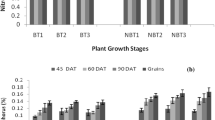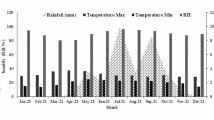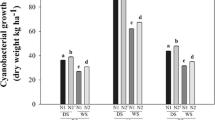Abstract
Irrigated transplanted flooded rice is a major source of methane (CH4) emission. We carried out experiments for 2 years in irrigated flooded rice to study if interventions like methane-utilizing bacteria, Blue-green algae (BGA), and Azolla could mitigate the emission of CH4 and nitrous oxide (N2O) and lower the yield-scaled global warming potential (GWP). The experiment included nine treatments: T1 (120 kg N ha−1 urea), T2 (90 kg N ha−1 urea + 30 kg N ha−1 fresh Azolla), T3 (90 kg N ha−1 urea + 30 kg N ha−1 Blue-green algae (BGA), T4 (60 kg N ha−1 urea + 30 kg N ha−1 BGA + 30 kg N ha−1 Azolla, T5 (120 kg N ha−1 urea + Hyphomicrobium facile MaAL69), T6 (120 kg N ha−1 by urea + Burkholderia vietnamiensis AAAr40), T7 (120 kg N ha−1 by urea + Methylobacteruim oryzae MNL7), T8 (120 kg N ha−1 urea + combination of Burkholderia AAAr40, Hyphomicrobium facile MaAL69, Methylobacteruim oryzae MNL7), and T9 (no N fertilizer). Maximum decrease in cumulative CH4 emission was observed with the application of Methylobacteruim oryzae MNL7 in T7 (19.9%), followed by Azolla + BGA in T4 (13.2%) as compared to T1 control. N2O emissions were not significantly affected by the application of CH4-oxidizing bacteria. However, significantly lower (P<0.01) cumulative N2O emissions was observed in T4 (40.7%) among the fertilized treatments. Highest yields were observed in Azolla treatment T2 with 25% less urea N application. The reduction in yield-scaled GWP was at par in T4 (Azolla and BGA) and T7 (Methylobacteruim oryzae MNL7) treatments and reduced by 27.4% and 15.2% in T4 and T7, respectively, as compared to the T1 (control). K-means clustering analysis showed that the application of Methylobacteruim oryzae MNL7, Azolla, and Azolla + BGA can be an effective mitigation option to reduce the global warming potential while increasing the yield.







Similar content being viewed by others
Data availability
All relevant data are within the manuscript and available from the corresponding author on request.
References
Adhya TK, Bharati K, Mohanty SR, Ramakrishnan B, Rao VR, Sethunthan N, Wassmann R (2000) Methane emission from rice fields at Cuttack, India. Nutr.Cycl.Agroecosys. 58:95–105
Ali MA, Farouque MG, Haque M, Kabir AU (2012) Influence of soil amendments on mitigating methane emissions and sustaining rice productivity in paddy soil ecosystems of Bangladesh. J Environ Sci Nat Resour 5:179–185
Ali MA, Kim PJ, Inubushi K (2015) Mitigating yield-scaled greenhouse gas emissions through combined application of soil amendments: a comparative study between temperate and subtropical rice paddy soils. Sci Total Environ 529:140–148
Aliyu G, Jiafa LUO, Deyan LIU, Junji YUAN, Zengming CHEN, Tiehu HE, Weixin DING (2021) Yield-scaled nitrous oxide emissions from nitrogen-fertilized croplands in China: a meta-analysis of contrasting mitigation scenarios. Pedosphere 31(2 (2021)):231–242
Aulakh MS, Bodenbender J, Wassmann R, Rennenberg H (2000) Methane trasport capacity of rice plants. II. In variations among different rice cultivars and relationship with morphological characteristics. Nutr Cycl Agroecosyst 58:367–375
Bédard C, Knowles R (1989) Physiology, biochemistry, and specific inhibitors of CH4, NH4+, and CO oxidation by methanotrophs and nitrifiers. Microbiol Rev 53:68–84. https://doi.org/10.1128/mmbr.53.1.68-84.1989
Bharati K, Mohanty SR, Singh DP, Rao VR, Adhya TK (2000) Influence of incorporation or dual cropping of Azolla on methane emission from a flooded alluvial soil planted to rice in eastern India. Agric Ecosyst Environ 79:73–83
Bhatia A, Pathak H, Jain N, Singh PK, Singh AK (2005) Global warming potential of manure amended soils under rice–wheat system in the Indo-Gangetic plains. Atmos Environ 39:6976–6984
Bhatia A, Ghosh A, Kumar V, Tomer R, Singh SD, Pathak H (2011) Effect of elevated tropospheric ozone on methane and nitrous oxide emission from rice soil in north India. Agric Ecosyst Environ 144:21–28
Bhatia A, Pathak H, Jain N, Singh PK, Tomer R (2012) Greenhouse gas mitigation in rice–wheat system with leaf color chart-based urea application. Environ Monit Assess 184(5):3095–3107
Bhatia A, Kumar A, Das TK, Singh J, Jain N, Pathak H (2013) Methane and nitrous oxide emissions from soils under direct seeded rice. Int J Agric Stat Sci 9(2):729–736
Bhattacharyya P, Dash PK, Swain CK, Padhy SR, Roy KS, Neogi S, Berliner J, Adak T, Pokhare SS, Baig MJ, Mohapatra T (2019) Mechanism of plant mediated methane emission in tropical lowland rice. Sci Total Environ 651:84–92
Bremner JM (1997) Sources of nitrous oxide in soils. Nutr Cycl Agroecosyst 49(7):16
Chen GX, Huang GH, Huang B, Yu KW, Wu J, Xu H (1997) Nitrous oxide and methane emissions from soil–plant systems. Nutr Cycl Agroecosyst 49:41–45
Choudhaury ATMA, Kennedy IR (2005) Nitrogen fertilizer losses from rice soils and control of environmental pollution problems. Commun Soil Sci Plant Anal 36:1625–1639
Conrad R (2007) Microbial ecology of methanogens and methanotrophs. Adv Agron 96:1–63
Das S, Adhya TK (2014) Effect of combine application of organic manure and inorganic fertilizer on methane and nitrous oxide emissions from a tropical flooded soil planted to rice. Geoderma. 213:185–192
Datta A, Yeluripati JB, Nayak DR, Mahata KR, Santra SC, Adhya TK (2013) Seasonal variation of methane flux from coastal saline rice field with the application of different organic manures. Atmos Environ 66:114–122
Davamani V, Parameswari E, Arulmani S (2020) Mitigation of methane gas emissions in flooded paddy soil through the utilization of methanotrophs. Sci Total Environ 726:138570. https://doi.org/10.1016/j.scitotenv.2020.138570
Dedysh SN, Dunfield PF (2011) Facultative and obligate methanotrophs: how to identify and differentiate them. Methods Enzymol 495:31–44
Dong H, Yao Z, Zheng X, Mei B, Xie B, Wang R, Deng J, Cui F, Zhu J (2011) Effect of ammonium-based, non-sulfate fertilizers on CH4 emissions from a paddy field with a typical Chinese water management regime. Atmos Environ 45:1095–1101
Dubey SK (2005) Microbial ecology of methane emission in rice agroecosystem: a review. Appl Ecol Environ Res 3:1–27
Dubey SK, Singh JS (2001) Plant-induced spatial variations in the size of methanotrophic population in dryland and flooded rice agroecosystems. Nutr Cycl Agroecosyst 59:161–167
Gupta DK, Bhatia A, Kumar A, Das TK, Jain N, Tomer R, Malyan SK, Fagodiya RK, Dubey R, Pathak H (2016) Mitigation of greenhouse gas emission from rice–wheat system of the Indo-Gangetic plains: through tillage, irrigation and fertilizer management. Agric Ecosyst Environ 230:1–9
Hanson RS, Hanson TE (1996) Methanotrophic bacteria. Microbiol Rev 60:439–471
Hussain S, Peng S, Fahad S, Khaliq A, Huang J, Cui K, Nie L (2015) Rice management interventions to mitigate greenhouse gas emissions: a review. Environ Sci Pollut Res 22:3342–3360
Iguchi H, Yurimoto H, Sakai Y (2015) Interactions of methylotrophs with plants and other heterotrophic bacteria. Microorganisms. 3:137–151
Inubushi K, Naganuma H, Kitahara S (1996) Contribution of denitrification and autotrophic and heterotrophic nitrification to nitrous oxide production in andosols. Biol Fertil Soils 23:292–298
IPCC (2014) Climate Change 2014: Impacts, Adaptation, and Vulnerability Working Group II Contribution to the Fifth Assessment Report. Cambridge University Press, Cambridge, UK and New York, NY USA
Jain N, Arora P, Tomer R, Vind S, Bhatia A, Pathak H, Chakraborty D, Kumar V, Dubey DS, Harit RC, Singh JP (2016) Greenhouse gases emission from soils under major crops in Northwest India. Sci Total Environ 542:551–561
Kantachote D, Nunkaew T, Kantha T, Chaiprapat S (2016) Biofertilizers from Rhodopseudomonas palustris strains to enhance rice yields and reduce methane emissions. Appl Soil Ecol 100:154–161
Kim Y, Talucder MSA, Kang M, Shim K-M, Kang N, Kim J (2016) Interannual variations in methane emission from an irrigated rice paddy caused by rainfalls during the aeration period. Agric Ecosyst Environ 223:67–75
Kimani SM, Cheng W, Kanno T, Nguyen-Sy T, Abe R, Oo AZ, Tawaraya K, Sudo S (2018) Azolla cover significantly decreased CH4 but not N2O emissions from flooding rice paddy to atmosphere. J Soil Sci Plant Nutr 64:68–76
Kollah B, Patra AK, Mohanty SR (2016) Aquatic microphylla Azolla: a perspective paradigm for sustainable agriculture, environment and global climate change. Environ Sci Pollut Res 23:4358–4369
Kumar A, Medhi K, Fagodiya KR, Subrahmanyam G, Mondal R, Raja P, Malyan SK, Gupta DK, Gupta CK, Pathak H (2020) Molecular and ecological perspectives of nitrous oxide producing microbial communities in agro-ecosystems. Rev Environ Sci Biotechnol 19(4):717–750
Ladha JK, Pathak H, Krupnik TJ, Six J, Kessel C (2005) Efficiency of fertilizer nitrogen in cereal production: retrospects and prospects. Adv Agron 87:85–156
Liessens J, Germonpre R, Kersters I, Beernaert S, Verstraete W (1993) Removing nitrate with a methylotrophic fluidized bed: microbiological water quality. J Am Water Works Assoc 85:155–161
Liu J, Xu H, Jiang Y, Zhang K, Hu Y, Zeng Z (2017) Methane emissions and microbial communities as influenced by dual cropping of Azolla along with early rice. Sci Rep 7:40635
Ma YY, Tong G, Wang WQ, Zeng CS (2012) Effect of Azolla on CH4 and N2O emissions in Fuzhou Plain paddy fields.pdf. Chin J Eco-Agric 20:723–727
Malla G, Bhatia A, Pathak H, Prasad S, Jain N, Singh J, Kumar V (2005) Mitigating nitrous oxide and methane emissions from soil under rice–wheat system with nitrification inhibitors. Chemosphere 58:141–147. https://doi.org/10.1016/j.chemosphere.2004.09.003
Malyan SK, Bhatia A, Kumar A, Gupta DK, Singh R, Kumar SS, Tomer R, Kumar O, Jain N (2016) Methane production, oxidation and mitigation: a mechanistic understanding and comprehensive evaluation of influencing factors. Sci Total Environ 572:874–896
Malyan SK, Bhatia A, Kumar SS, Fagodiya RK, Pugazhendhi A, Duc PA (2019) Mitigation of greenhouse gas intensity by supplementing with Azolla and moderating the dose of nitrogen fertilizer. Biocatal Agric Biotechnol 20:101266
McDonald IR, Doronina NV, Trotsenko YA, McAnulla C, Murrell JC (2002) Hyphomicrobium chloromethanicum sp. nov. and Methylobacterium chloromethanicum sp. nov., chloromethane-utilizing bacteria isolated from a polluted environment. Int J Syst Evol Microbiol 51(Pt 1):119–122. https://doi.org/10.1099/00207713-51-1-119
Moldenhauer KEWC, Slaton N (2001) Rice growth and development. Rice production handbook, pp 7–14
Pathak H, Bhatia A, Prasad S, Kumar S, Jain MC, Kumar U (2002) Emission of nitrous oxide from rice–wheat systems of Indo-Gangetic Plains of India. Environ Monit Assess 77:163–178
Pathak H, Prasad S, Bhatia A, Singh S, Kumar S, Singh J, Jain MC (2003) Methane emission from rice–wheat cropping system in the Indo-Gangetic plain in relation to irrigation, farmyard manure and dicyandiamide application. Agric Ecosyst Environ 97(1-3):309–316
Prasanna R, Kumar V, Kumar S, Yadav AK, Tripathi U, Singh AK, Jain MC, Gupta P, Singh PK, Sethunathan N (2002) Methane production in rice soil is inhibited by cyanobacteria. Microbiol Res 157:1–6
Rani V, Bhatia A, Kaushik R (2021a) Inoculation of plant growth promoting-methane utilizing bacteria in different N-fertilizer regime influences methane emission and crop growth of flooded paddy. Sci Total Environ 145826. https://doi.org/10.1099/00221287-61-2-205
Rani V, Bhatia A, Nain L, Tomar GS, Kaushik R (2021b) Methane utilizing plant growth-promoting microbial diversity analysis of flooded paddy ecosystem of India. World J Microbiol Biotechnol 37(4):1–22
Ritchie H, Roser M (2018) CO2 and other greenhouse gas emissions. Published online at OurWorldInData.org. Retrieved from: https://ourworldindata.org/co2-and-other-greenhouse-gas-emissions. Accessed Dec 2019
Sass RL, Cicerone RJ (2002) Photosynthate allocations in rice plants: food production or atmospheric methane? Proc Natl Acad Sci U S A 99(19):11993–11995
Schimel J (2000) Rice, microbes and methane. Nature. 403:375–377
Shin D, Lee S, Kim TH, Lee JH, Park J, Lee J, Nam HG (2020) Natural variations at the Stay-Green gene promoter control lifespan and yield in rice cultivars. Nat Commun 11(1):1–11
Singh SK, Bharadwaj V, Thakur TC, Pachauri PC, Singh PP, Mishra AK (2009) Influence of crop establishment methods on methane emission from rice fields. Curr Sci 97:84–89
Tan W, Yu H, Huang C, Li D, Zhang H, Jia Y, Wang G, Xi B (2018) Discrepant responses of methane emissions to additions with different organic compound classes of rice straw in paddy soil. Sci Total Environ 630:141–145
Tariq A, Vu QD, Jensen SL, Tourdonnet S, Sander OB, Wassmann R, Mai TV, Neergaard A (2017) Mitigating CH4 and N2O emissions from intensive rice production systems in northern Vietnam: efficiency of drainage patterns in combination with rice residue incorporation. Agric Ecosyst Environ 249:101–111
Theisen AR, Murrell JC (2005) GUEST COMMENTARY Facultative Methanotrophs Revisited. Society 187:4303–4305
Tyler SC, Bilek RS, Sass RL, Fisher FM (1997) Methane oxidation and pathways of production in a Texas paddy field deduced from measurements of flux, delta-C-13, and delta-D of CH4. Glob Biogeochem Cycles 11:323–348
Van Aken B, Peres CM, Doty SL, Yoon JM, Schnoor JL (2004) Methylobacterium populi sp. nov., a novel aerobic, pink-pigmented, facultatively methylotrophic, methane-utilizing bacterium isolated from poplar trees (Populus deltoides x nigra DN34). Int J Syst Evol Microbiol 54:1191–1196
Wagner GM (1997) Azolla: a review of its biology and utilization. Bot Rev 63:1–26
Whittenbury R, Davies SL, Wilkinson JF (1970) Enrichment, isolation and some properties of methane-utilizing bacteria. J Gen Microbiol 61:205–218. https://doi.org/10.1099/00221287-61-2-205
Xie B, Zheng X, Zhou Z, Gu J, Zhu B, Chen X (2010) Effects of nitrogen fertilizer on CH4 emission from rice fields: multi-site field observations. Plant Soil 326:393–401
Xu H, Zhu B, Liu J, Li D, Yang Y, Zhang K, Jiang Y, Hu Y, Zeng Z (2017) Azolla planting reduces methane emission and nitrogen fertilizer application in double rice cropping system in southern China. Agron Sustain Dev 37. https://doi.org/10.1007/s13593-017-0440-z
Yao Z, Zheng X, Wang R, Liu C, Lin S, Butterbach-Bahl K (2019) Benefits of integrated nutrient management on N2O and NO mitigations in water-saving ground cover rice production systems. Sci Total Environ 646:1155–1163
Ying Z, Boeckx P, Chen GX, Cleemput OV (2000) Influence of Azolla on CH4 emission from rice fields. Nutr.Cycl.Agroecosyst. 58:321–326
Yu, K., Wang, Z., Vermoesen, A., Patrick Jr, W. and Van Cleemput, O., 2001. Nitrous oxide and methane emissions from different soil suspensions: effects of soil redox status.
Zhao X, Pu C, Ma ST, Liu SL, Xue JF, Wang X, Wang YQ, Li SS, Lal R, Chen F, Zhang HL (2019) Management-induced greenhouse gases emission mitigation in global rice production. Sci Total Environ 649:1299–1306
Acknowledgments
We thank the Director, Dean, and PG School of Indian Agricultural Research Institute, New Delhi for providing all facilities required in this study. We are also thankful to Head, Dr. G. Abraham and Dr. Sunil Pabbi, Division of Microbiology, IARI, for providing Azolla and BGA for experimentation. Financial support to S.K.M. during Ph.D. as UGC-JRF/SRF provided by University Grant Commission (UGC) is gratefully acknowledged. This study has been supported by the grant of National Innovations in Climate Resilient Agriculture (NICRA, IARI/112-15) project.
Author information
Authors and Affiliations
Contributions
S.K.M.: investigation, writing—original draft. A.B.: conceptualization, supervision, writing—review and editing. R.T.: sample analysis. R.C.H.: field management. A.B.: statistical analysis. N.J.: writing—initial draft. R.K.: conceptualization, supervision.
Corresponding author
Ethics declarations
Ethical approval
Not applicable.
Consent for participate
The authors have agreed with the content and all have given consent to publish.
Competing interests
The authors declare no competing interests.
Additional information
Responsible Editor: Philippe Garrigues
Publisher’s note
Springer Nature remains neutral with regard to jurisdictional claims in published maps and institutional affiliations.
Rights and permissions
About this article
Cite this article
Malyan, S.K., Bhatia, A., Tomer, R. et al. Mitigation of yield-scaled greenhouse gas emissions from irrigated rice through Azolla, Blue-green algae, and plant growth–promoting bacteria. Environ Sci Pollut Res 28, 51425–51439 (2021). https://doi.org/10.1007/s11356-021-14210-z
Received:
Accepted:
Published:
Issue Date:
DOI: https://doi.org/10.1007/s11356-021-14210-z




